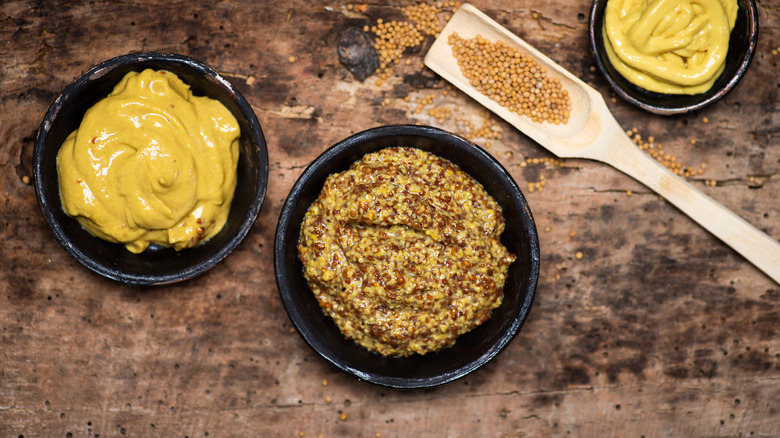The 2 Mustard Brands Ina Garten Can't Go Without
Before Ina Garten was a Food Network star, she owned a specialty grocery store in her neighborhood in the Hamptons called, you guessed it, the Barefoot Contessa. Not only did the store inspire its namesake cooking show, but the years she spent in the specialty food industry served as fodder for the countless recipes and cookbooks she's published. During her years as a specialty grocer, Garten had access to a vast array of pantry items, but it is two particular types of mustard that always grace her shelves.
During a visit to her home, Bon Appétit learned that the two mustard brands Garten can't go without are Grey Poupon and Maille. Grey Poupon is more ubiquitous than Maille in North America, but regardless of the brand, each type of mustard has distinct qualities. Both Grey Poupon's dijon and Maille's whole grain mustard are made with black and/or brown mustard seeds, giving them a nice punch of heat and spice, and both are also elaborated with vinegar and white wine, providing a tangy sweetness to tamper mustard seed's heat. The main difference between the two is texture; dijon mustard grinds the seeds into a creamier, more uniform texture while whole grain mustard keeps the seeds intact, providing a lumpy, less coherent paste and pleasant popping crunch.
How to use dijon and whole-grain mustard
Ina Garten argues for the importance of both mustard brands because she uses them jointly in many recipes, from sauces to glazes, to salad dressings. They offer a strong, spicy, and sweet mustard flavor while their complementary textures make sauces both creamy and crunchy.
A few noteworthy recipes Garten has shared in her cookbooks and on Food Network use whole grain and dijon as a spicy complement for meat, fish, and poultry. She cooks pan-fried Chicken Thighs with Creamy Mustard Sauce with white wine and creme fraiche. She serves kielbasa and steak with extra spicy mustard and horseradish sauce that stands up to the richness of red meat. For fish, Garten puts a briny, aromatic twist on the creamy mustard sauce used on the pan-fried chicken with the addition of capers and shallots.
Dijon is a common ingredient in ham glazes and as a spicy crust for a rack of lamb. Dijon's most popular application is in salad dressings, from Caesar to honey mustard, to various vinaigrettes. You could add half dijon and half whole grain mustard for a more diversified texture to dressings. You could also blend the two with mayonnaise and honey for a creamy soft pretzel dipping sauce. Whole grain mustard stands alone in its fair share of dishes, as well; it makes a great spread for sandwiches or a garnish for cheese plates.

